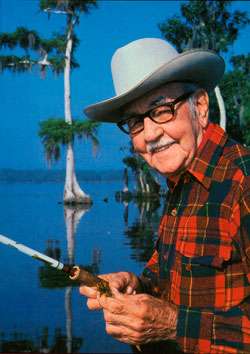
Very few people realize that television has been around since 1927. Almost as few know there were outdoor programs on television as early as 1939. That's when Roscoe Vernon Gaddis debuted on W2XD (now WRGB) in Schenectady, N.Y.
Born in Mattoon, Ill., in 1896, Gaddis got his start at fishing when he was seven years old and his grandmother took him to the Okaw River in Illinois.
"I felt a whole new world open up to me — something very special."
At the age of 16, he dropped out of school to roam the countryside, stopping to fish whenever and wherever he had the chance.
Gaddis explained, "I've had the hankering to roam since I could walk; to fish since I was seven. Except for a few remote childhood fancies, I've never really wanted to do anything else. And so I haven't done anything else."
"Gadabout" came by his nickname honestly. By the time he was 17 his family had lived in seven towns spread across five states.
In the 1930s, during the Great Depression, Gaddis was a traveling tackle salesman, and his friends called him "Vern." In 1938, everything changed for the loquacious angler.
As part of his sales duties, Gaddis would make appearances at sportsmen's clubs to show off the latest wares. It became common for those in attendance to tell him that he had a voice and personality for radio.
One day he met a radio programmer from WGY, an NBC affiliate in Schenectady, who signed Gaddis to do a weekly series of 15-minute fishing programs. When his bosses at the tackle company heard the news, they decided to sponsor the show.
He picked up the nickname "Gadabout" at WGY when staffers were thinking up a name for the show. One of them said, "Why don't you call him 'Gadabout' Gaddis? That's a good name for him because every time we're looking for him he's gaddin' about the country somewhere."
The nickname stuck, though Gaddis didn't like it at first.
A year later, General Electric came to him and offered him a spot on their new television station in New York. He had been making fishing travel films for several years by this point, but knew little of the new medium.
His first television program ran for 15 minutes each Friday night during the summer of 1939. In those days, television was only broadcast a couple of hours each day. The newspapers didn't print the television schedule, so local stations mailed it out each week on a penny postcard to every television owner.
The Flying Fisherman series was born, combining three of Gaddis' great passions — fishing, filming and flying.
After the Japanese attacked Pearl Harbor in 1941, Gaddis looked for a way to contribute to the war effort. At more than 40 years of age, he doubted he could serve as a pilot, but he thought the troops might enjoy his fishing films. After being turned down as an enlistee for the Army Air Corps, he put together a touring show with his films to entertain the troops. It was a big success.
The U.S. military set up a program under which Gaddis toured Air Corps camps and hospitals, showing and narrating his fishing movies and taking out groups of servicemen for fishing trips — sometimes 20-30 boats at a time. He later called that period between 1942 and 1945 "one of the most rewarding of my life."
Gaddis' next career break came in 1963 when Liberty Mutual Insurance Company signed a five-year contract to sponsor The Flying Fisherman and put it in 50 television markets across the country. It made Gaddis a household name… at least among anglers.
America's most famous angler had a simple philosophy when it came to television, and it served him well for many years.
"I'm no expert. I never have been and I never will be. I am just an average fisherman who builds pictures for the average fisherman. That's why I steer clear of expensive resorts while filming. I go only where the typical angler can afford to go…. I don't want any advantages the run-of-the-mill fisherman doesn't have.
"Above all my series is believable. It has to be. I film what happens. If I come up dry and don't catch a fish, that's what we show. If I get hung up on a tree, you'll see it. And if I slip on a rock, you'll see that too.
"People watch these things happen to me on television, laugh and say to themselves, 'I guess I'm not the only darn fool who's had that happen to him.'"
Over his decades of traveling and filming, Gaddis fished in every state but Hawaii and in many foreign countries. He was seemingly always on the move and said he couldn't recall spending 30 consecutive nights under one roof.
Responding to the envious charge of a fan that he led a charmed life, Gaddis said, "Mister, it's been the darndest life any three men together could ever have. I do have it made. I'd be fibbing if I tried to deny it. I'm doing exactly what I always wanted to do — fish and gallivant."
The Flying Fisherman was a staple of outdoors programming into the 1970s. Gaddis died in 1986, at the age of 90, calling himself "the luckiest man alive" right to the end.
